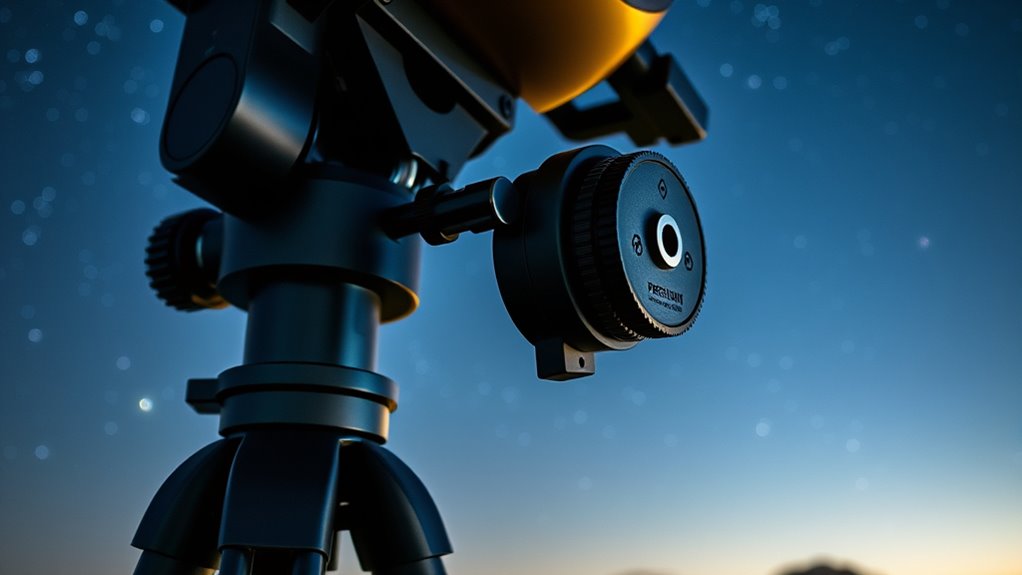Based on my research, the iEXOS-100-2 PMC-Eight Astrophotography Tracker System offers excellent precision thanks to its belt drive design, which minimizes backlash and guarantees smooth, accurate movement. It supports substantial loads and operates quietly, ideal for astrophotography. Its stability and compatibility with various software make it easy to calibrate and reliable during long sessions. Keep exploring to discover more about how this mount can elevate your astrophotography experience.
Key Takeaways
- Look for mounts with high-quality belt drive systems offering minimal backlash and backlash compensation for precise tracking.
- Ensure the mount supports appropriate load capacities to handle your astrophotography gear securely.
- Prioritize models with stable, vibration-dampening tripods and smooth motor operation for consistent imaging.
- Compatibility with popular guiding and control software like ASCOM, INDI, or SkySafari enhances calibration ease.
- Choose mounts with user-friendly calibration features, quick setup, and reliable performance for optimal astrophotography results.
iEXOS-100-2 PMC-Eight Astrophotography Tracker System Tripod and Mount
If you’re starting out in astrophotography and want a reliable, easy-to-use mount with belt drive systems, the iEXOS-100-2 PMC-Eight is an excellent choice. This system features eight independent CPUs, delivering fast responsiveness and dependable performance. Its quiet stepper motor belt drives and clutched dual-axis worm gears allow smooth, precise adjustments. The intuitive ExploreStars app simplifies alignment and navigation, compatible with Apple, Android, and Windows devices. With a sturdy tripod, polar sight hole, and support for WiFi and Bluetooth, it’s portable and user-friendly. While some initial calibration tweaks are needed, it offers solid value for beginners seeking accurate tracking in a lightweight package.
Best For: beginner to intermediate astrophotographers seeking a lightweight, reliable, and easy-to-use tracking system with quiet operation and smartphone compatibility.
Pros:
- Intuitive ExploreStars app simplifies alignment and navigation.
- Quiet stepper motor belt drives for smooth and precise adjustments.
- Portable and lightweight design ideal for field use.
Cons:
- Initial GoTo accuracy may require calibration adjustments.
- Tripod legs can be flimsy and may need tightening or modifications.
- Limited azimuth adjustment features without extra-cost accessories.
Factors to Consider When Choosing Equatorial Mounts With Belt Drive Systems

When selecting an equatorial mount with a belt drive system, I focus on factors like precision, load capacity, and noise levels to guarantee reliable performance. It’s also important to take into account power requirements and how stable the mount is during long observations or astrophotography sessions. By evaluating these points, you can choose a mount that meets your specific needs and provides smooth, accurate tracking.
Belt Drive Precision
Choosing a belt drive system for an equatorial mount hinges on understanding how various factors influence its precision. The elasticity and tension of the belt are critical; properly adjusted belts ensure minimal periodic error and smooth tracking. High-quality belts and pulleys are essential, as they enable sub-arcsecond guiding performance when calibrated correctly. Belt drives also produce less backlash, wear, and gear slop compared to traditional gear systems, maintaining consistent accuracy over time. Additionally, the synchronization between belt tension and motor control algorithms plays a crucial role in achieving high-precision tracking, especially during long exposures. Overall, selecting a system with well-engineered belt components and proper tension adjustment is key to maximizing the mount’s guiding accuracy and minimizing errors during astrophotography sessions.
Load Capacity Limits
The load capacity of an equatorial mount with a belt drive system is a critical factor that directly influences its stability and tracking accuracy. If you exceed the recommended weight, you risk gear slippage, increased wear, and reduced guiding precision, which can ruin your astrophotography sessions. Manufacturers specify load limits based on the mount’s design, gear strength, and motor power, so it’s essential to follow these guidelines. Proper weight distribution across the axes helps prevent undue stress and ensures smooth tracking. Upgrading to a mount with a higher load capacity can give you more flexibility for heavier accessories or longer imaging sessions. Always consider your equipment’s total weight and adhere to the specified limits to maintain ideal performance and longevity of your mount.
Motor Noise Levels
Have you ever noticed how much quieter belt drive systems are compared to traditional gear setups? That’s because belts operate smoothly and with low friction, resulting in less mechanical noise during tracking or slewing. The noise level can vary depending on the quality of the belts and pulleys; high-quality components produce minimal sound and help maintain a quiet environment. This quiet operation is especially beneficial for astrophotography sessions where noise can be disruptive. Advanced belt drive designs often include vibration dampening features, making the mounts nearly silent. However, some noise may still be audible at higher speeds or during rapid slewing, but overall, belt drives considerably reduce motor noise compared to gear-based systems. This quiet performance enhances your observing experience and minimizes disturbances.
Power Supply Needs
Since belt drive systems operate smoothly with minimal noise, maintaining a stable power supply becomes essential to keep performance consistent. An unstable power source can cause slewing or tracking errors, especially during long imaging sessions. Many mounts are compatible with various power options, like battery packs, AC adapters, or portable power tanks, which should match the voltage and current specifications from the manufacturer. Some mounts have onboard rechargeable batteries, enhancing portability, while others depend on external sources. Proper power management, including backup options and filters, helps prevent voltage drops and interruptions, extending the electronics’ lifespan and ensuring reliable operation. Ultimately, selecting a power supply that provides consistent, clean power is vital for achieving precise tracking and successful astrophotography.
Mount Stability Features
Achieving stable and precise astrophotography results depends heavily on the mount’s construction and adjustment features. A solid, well-engineered tripod base minimizes vibrations and keeps the mount steady during long exposures. Belt drive systems enhance stability by providing smooth, backlash-free movement, reducing jitter that can blur images. Incorporating dual-axis clutched worm gears allows me to lock both axes securely, preventing unwanted shifts and preserving alignment. Precise altitude and azimuth adjustments let me fine-tune positioning, counteracting environmental factors like wind or uneven ground. Additionally, high-quality materials such as reinforced aluminum or steel boost durability and stability under various observing conditions. Together, these features ensure the mount remains steady, accurate, and reliable, forming the foundation for high-quality astrophotography.
Compatibility Options
When selecting an equatorial mount with a belt drive system, compatibility with your existing equipment and control software is essential. Many mounts support various software protocols like ASCOM, INDI, and proprietary apps, making integration smoother. Support for connection types such as WiFi, Bluetooth, USB, and serial ports offers flexible control options across different devices and platforms. Compatibility with guiding software like PHD2 and planetarium apps such as SkySafari or Stellarium is critical for accurate tracking. Some mounts require specific firmware versions or hardware adapters to work seamlessly with third-party controllers or software. Additionally, verifying that the mount’s motor and encoder specs align with your astrophotography or observational gear is indispensable for reliable, precise operation. Compatibility ensures a seamless experience and peak performance.
Ease of Calibration
Choosing an equatorial mount with belt drive systems can be straightforward if it offers simple, user-friendly calibration features. Mounts with smoother motion reduce backlash and jitter, making the alignment process easier. Automated or software-assisted calibration tools also cut setup time and boost confidence, especially for beginners. Precise, easily adjustable polar alignment aids like polar scopes or sight holes allow for quick, accurate calibration without complex procedures. Additionally, mounts that require minimal hardware adjustments or extra accessories simplify setup and minimize user errors. Overall, a mount with intuitive calibration options, smooth motion, and helpful alignment tools ensures a faster, more reliable setup, letting you focus on capturing stunning astrophotos rather than wrestling with complicated calibrations.
Frequently Asked Questions
How Do Belt Drive Systems Reduce Vibration During Astrophotography?
Belt drive systems reduce vibration during astrophotography by providing smoother, quieter motion compared to traditional gear systems. I’ve found that belts absorb shocks and eliminate backlash, which helps keep my images sharp. They also minimize gear noise and rapid movements, allowing for more stable tracking. This stability is essential for capturing long-exposure images, and I notice less jitter and vibrations, resulting in clearer, more detailed astrophotos.
Can Belt Drive Mounts Be Upgraded for Better Performance Later?
Yes, belt drive mounts can be upgraded for improved performance later. You can replace the belts with higher-quality, low-stretch alternatives, upgrade the motors for smoother tracking, or add advanced control systems for precision. These upgrades can enhance stability, accuracy, and noise reduction. I recommend researching compatible parts and consulting with manufacturers or experts to guarantee seamless integration and ideal results.
What Is the Typical Lifespan of Belts in These Mounts?
Belt drives in mounts typically last around 3 to 5 years, but this depends on usage and maintenance. I’ve found that regular inspection, cleaning, and occasional replacement can extend their lifespan markedly. If you notice slipping or noise, it’s time to check the belts. Proper care ensures your mount stays precise, especially during long astrophotography sessions. I recommend keeping spares handy for quick upgrades when needed.
Are Belt Drive Systems Suitable for Deep-Sky Astrophotography?
Yes, belt drive systems are excellent for deep-sky astrophotography. They provide smoother, more precise movements, minimizing vibrations that can ruin long exposures. I’ve found that their quiet operation and reduced backlash help me capture sharper images of galaxies and nebulae. Plus, with proper maintenance, belts tend to last a good while, making them a reliable choice for serious astrophotographers like myself.
How Do Belt Drives Compare to Gear Drives in Maintenance Requirements?
Belt drives generally require less maintenance than gear drives because they have fewer moving parts and are less prone to wear and tear. I find that belts don’t need lubrication or regular adjustments like gears do, making them more convenient for frequent use. However, I still check the belts periodically for signs of stretching or damage to guarantee peak performance. Overall, belt drives are easier to maintain and more reliable over time.
Conclusion
Choosing the right belt drive equatorial mount is like selecting a trusty steed for a night sky adventure. With the right balance of precision, stability, and quiet operation, you’ll navigate the cosmos smoothly and confidently. Think of your mount as the steady hand guiding your telescope through the universe’s mysteries. When you pick the best system for your needs, your astrophotography journey becomes a seamless voyage into the stars.











